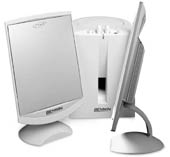Benwin BW2000 Flat Panel Speakers
by Mike Andrawes on June 6, 1999 6:40 PM EST- Posted in
- Smartphones
- Mobile
Technology Overview
Take a look at a speaker from 30 years ago and your average speaker from today. Other than possible deterioration in the older speaker, they really aren't all that different - the basic principal of a conical diaphragm moving back and forth as a rigid body, usually by electromagnetic transduction is the same. The problem with such a setup is that there is a tendency to produce a colored and very directional sound. Most speaker research over the past 30 years or so has been aimed at reducing these colorations in the sound.
NXT's solution is to do something completely different - instead of using a pistonic diaphragm where it all moves rigidly, they decided to use a completely different approach. To quote NXT's white paper:
We appear to have reached an impasse, but some wonderful things happen if you abandon the concept of pistonic motion and consider instead a diaphragm vibrating randomly across its surface rather than coherently. Each small area of the panel vibrates, in effect, independently of its neighbours, rather than in the fixed, co-ordinated fashion of a pistonic diaphragm. Think of it as an array of very small drive units, each radiating a different, uncorrelated signal but summing to produce the desired output.
With the entire panel acting as an "array of very small drive units" a much larger "sweet spot" is generated and the sound seems to fill the room much better. A small exciter mounted directly behind the .25mm thick panel generates the necessary vibrations. No enclosure is required around the panel. The result is sound that emits directly from the front of the flat speaker.
That white paper from NXT is available online and explains in excruciating detail exactly how their technology works, what's wrong with traditional speakers, and how they've solved those issues. It's pretty detailed, but the general gist of the issues at hand is not too hard to grasp.
Design
In the case of the Benwin BW2000, the flat panel technology is used in a pair of satellites that are 7mm thick and augmented by a traditional subwoofer. The satellites feature a small removable stand for support. Volume for the whole system and the sub are mounted a top the sub, along with power and 3D sound toggle buttons. An LED indicates power status. With the controls located on the sub, it is clear that it is intended to go on top of the desk, not the floor like many other subwoofers. Fortunately, it is small enough to not be too obtrusive on top of the desk - smaller than the satellites of some other systems in fact!
The panels from which sound is generated measure about 5 inches by 6 inches. Each satellite gets 3W RMS power, while the sub gets 6W RMS. That sub uses traditional speaker technology in the form of a vertically mounted 3.15 inch driver and houses the system's amplifiers. The sub supposedly covers frequencies from 50 - 250Hz while the satellites handle 150Hz - 20kHz. 50Hz is quite low for a 3.15 inch sub, so we'll have to check on that carefully.
Setup is extremely simple - one cable provides the input to the system via a 1/8th mini plug, while a second 1/8th mini plug connects both satellites. An AC adapter powers the whole system. Snap the stands in place and your done. Unfortunately, the power brick is designed such that it may block an one additional outlet on a surge protector. All connections are made to the back of the subwoofer. An eleven page manual details this installation and includes some basic troubleshooting information.
With such thin speakers and the sound surface exposed directly, it seems like they would be extremely fragile. However, Benwin has assured us that they are tough and will hold up as well as a regular speaker. During testing, no special care was used and no damage was caused.











0 Comments
View All Comments